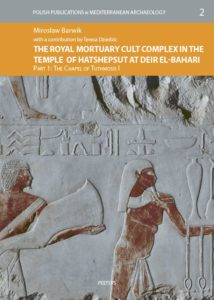-
BUY ONLINE

-
Mirosław Barwik with the contribution of Teresa Dziedzic, Deir el-Bahari. The Royal Mortuary Cult Complex in the Temple of Hatshepsut at Deir el-Bahari. Part 1, The Chapel of Tuthmosis I (=Polish Publications in Mediterranean Archaeology 2). Leuven–Paris–Bristol: Peeters Publishers.
Polish Publications in Mediterranean Archaeology is a PCMA UW book series published by Peeters Publishers.
This open-access publication was made possible with support from the Ministry of Education and Science program for “Internationalization of Research of the Archaeological Centres of the University of Warsaw in Egypt, Peru, Georgia and Montenegro”.
Leuven 2021
ISBN 9789042944251
e-ISBN: 9789042944268
pages: XX-99 p. + 33 pl.The volume is an editio princeps of the Chapel of Thutmosis I, a shrine located in the southern part of the upper terrace of the Theban funerary complex of Hatshepsut. The shrine was built by order of the queen to commemorate her father and housed the pharaoh’s mortuary cult in relation to that celebrated for the queen in the adjoining Chapel of Hatshepsut. Its decoration, patterned upon that of the Chapel of Hatshepsut, although significantly smaller in scale, follows iconographic schemes in vogue from the illustrious era of the Old Kingdom and the pyramid temples of the great pharaohs of more than a thousand years earlier.
Forgotten and completely demolished after the mortuary cults ceased to be celebrated in the royal temples at Deir el-Bahari, the chapel has been mostly inaccessible until now. It has now been studied and a reconstruction of its fragmented decoration has been proposed, linking the preserved remains and the separate blocks and fragments painstakingly positioned above them, to aid in the visual identification of what is in situ and what is not. An exhaustive architectural analysis appended to the volume, including axonometric views, places the decoration in the context of the temple and its building history.
“This publication is the culmination of many years of painstaking excavation, documentation, and restoration work at Deir el-Bahari, not to mention some sharp detective work outside of Egypt in the identification of fragmentary material … a major achievement and will be an outstanding contribution to Egyptology.” (Raymond W. Johnson, University of Chicago, Oriental Institute).
Mirosław Barwik, PhD hab., is an Egyptologist and archaeologist, author of studies on the history and culture of New Kingdom Egypt. He is an associate professor at the University of Warsaw Faculty of Archaeology and was a member of the PCMA UW Temple of Hatshepsut Project at Deir el-Bahari.
Teresa Dziedzic, PhD Eng. arch., is an architect and lecturer at the Wrocław University of Science and Technology, Institute of History of Art, Architecture and Technology. She specializes in historical architecture and has worked extensively with the PCMA UW Temple of Hatshepsut Project at Deir el-Bahari.
For download (PDF files):
